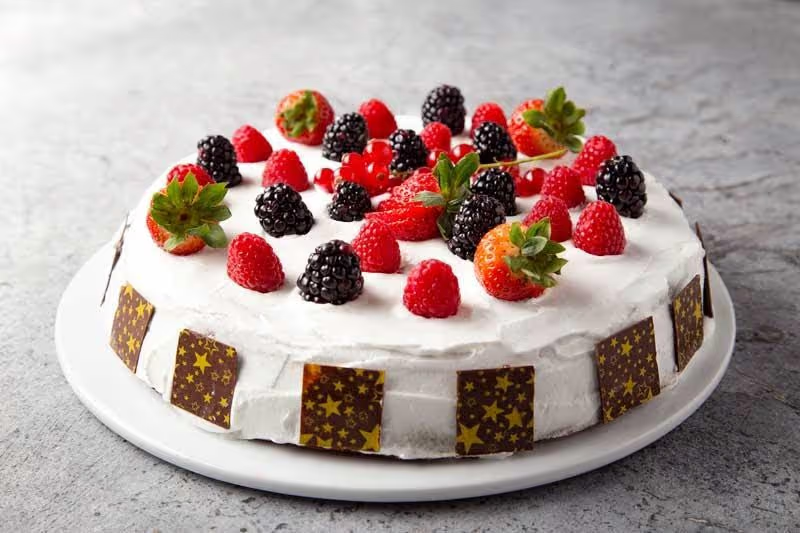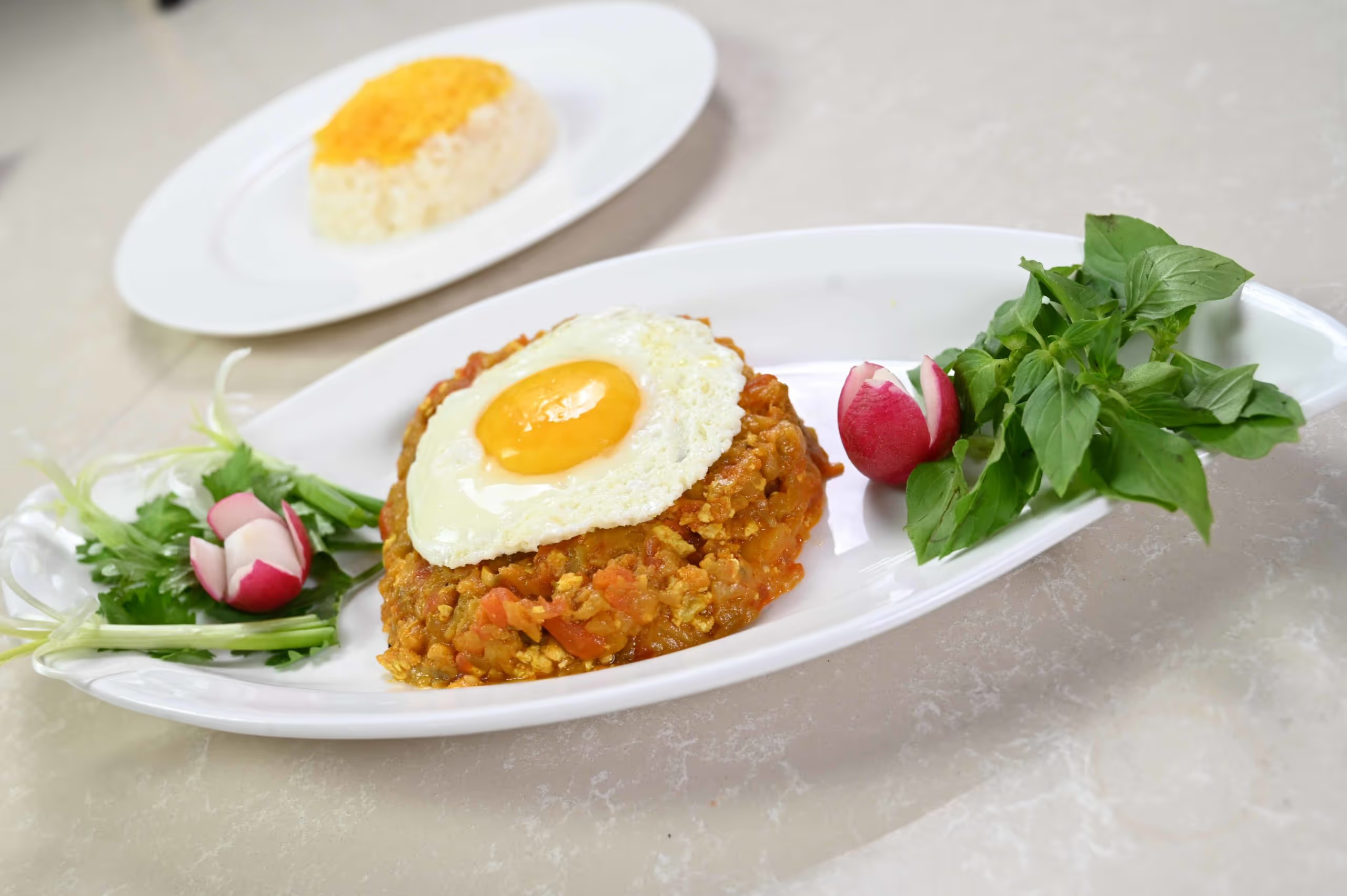The rich and intense dark chocolate makes the light aerated cake dense and moist which works well when garnished with a generous dusting of icing sugar.
Cakes are traditional sweet and savory food. Cakes differ from breads, in that they are richer and are eaten by themselves, rather than as an accompaniment. They are generally made from a mixture of flour, fat, eggs, sugar and other ingredients baked together and are also iced or decorated. They could also contain honey, fruits and nuts.
The ancient Egyptians were the first culture to show evidence of advanced baking skills, however they looked and tasted very differently from what we know of them today. The word ‘cake’ is of Viking origin, derived from the Old Norse word ‘Kaka’ and traced all the way back to the 13th Century, where the medieval European bakers would bake fruit cakes and ginger bread which would last for several months making it convenient for soldiers, as food for long journeys.
Cakes come in many shapes and styles, some of the commonly found shapes are; round, square, rectangle, oval, etc. However, the most popular shape remains round and the methods in which they are produced vary from different regions and cultures.
Some popular types of cakes include:
1. Sponge cake
Sponge cake is a light cake made with eggs, flour and sugar, sometimes leavened with baking powder. Sponge cakes, leavened with beaten eggs, originated during the Renaissance, possibly in Spain. The sponge cake is thought to be one of the first of the non-yeasted cakes, and the earliest attested sponge cake recipe in English is found in a book by the English poet Gervase Markham, The English Huswife, Containing the Inward and Outward Virtues Which Ought to Be in a Complete Woman (1615). Still, the cake was much more like a cookie: thin and crispy. Sponge cakes became the cake recognized today when bakers started using beaten eggs as a rising agent in the mid 18th century.
2. Pound cake
A rich cake that contains equal amounts of flour, butter, eggs and sugar.Example: Madeira cake & Victoria sandwich cake.
3. Layered cake
A cake consisting of several layers of cake filled with jam or cream. The flavor and fillings could vary as per taste. Example: Black forest cake, Red velvet cake.
4. Swiss Roll or jam roll
A cake consisting of a flat rectangular sponge cake traditionally spread with jam and rolled into a pinwheel. It is served in slices and sprinkled with icing sugar. Example: Chocolate roulade, Vanilla Swiss roll.
5. Cup Cakes
These are small cakes baked in cup cake tins. They are served in single portions and are individually decorated with frosting such as whipped cream, cream cheese, butter cream, etc. Example: Carrot cupcakes, Vanilla butter cream cupcakes.
6. Muffins
These come under the category of cupcakes, however muffins generally do not have a frosting on top. They could be topped with a crumble that enhances the texture and flavor of the muffin. Muffins are the same size or a little larger than regular sized cupcakes and could be sweet or savory which is what distinguishes them from cupcakes. Example: Blueberry muffin, Apple and cinnamon muffin.
7. Cake Bars
These are small slices of cakes and because of their high sugar content, they have a crispy texture similar to cookies and are also known as “bars” and “slices”. Example: Florentine slice, Brownies.
8. Occasion Cakes
These are Specialty cakes, specific to the occasion prepared for. These cakes would most often than not be layered and filled with a frosting, covered with a layer of marzipan and decorated with fondant. Some of the common occasions where specialty cakes feature are; Weddings, Birthdays, Graduation, Promotions and Weddings.
Cake Recipe of the Day - Flourless Chocolate Cake

About Flourless Chocolate Cake
Flourless chocolate cake is a delicious, dense and gluten free cake that comes from the island of Capri, Italy. It is most commonly served with powdered sugar; however, modern versions use ice cream or whipped cream.
It is believed that “Torta Caprese” was the first flourless chocolate cake of its kind and among the Italians, it is believed that this chocolaty goodness was actually an accident. There are many versions of this tale, but they all come to the same, conclusion; almond powder was mistakenly used instead of flour making it the first flourless cake and a great dessert option for people who suffer from gluten intolerance.
This Dish
The rich and intense dark chocolate makes the light aerated cake dense and moist which works well when garnished with a generous dusting of icing sugar.
Recipe Card
Method of Cooking
For the Cake
- Grease and line an 8-inch (20 centimeter) cake pan, and preheat the oven to 285˚F/140˚C.
- Roughly chop the chocolate and the butter and place them together in a mixing bowl; set the bowl over a sauce pan with simmering water, stirring the mixture occasionally to prevent the chocolate from burning. When the chocolate and butter have melted completely, take the pan off the heat and leave to cool.
- Whisk the eggs, vanilla essence and brown sugar until light, fluffy and pale in color.
- Add some egg mixture to the cooled chocolate mixture and mix it. Pour it back to the remaining egg and fold it together carefully with a rubber spatula.
- During the folding, add the almond powder little by little at the same time. Fold until just combined.
- Pour the mixture into the prepared cake tin.
- Bake it at 140˚C for 70 to 80 minutes. After the first 30 minutes of baking, you can put a wooden spoon in the doorway of the oven just to let the steam out, and carry on baking that way.
- Cool it down and put it in the fridge to set.
For the Whipping Cream
- Mix sifted icing sugar with the chilled whipped cream using a hand whisk.
- Whisk it with a hand held electric mixer /planetary mixer until firm.
- Transfer to a lidded container and keep it in the fridge until required to serve.
For Serving
- Place the cake on a platter.
- Spoon the whipped cream on the top of the cake and spread in a circular motion with a palette knife to form an even layer. The rest of the whipping cream can be served separately.
- Sieve a little cocoa powder on top of the cream to give it a nice contrast of color and serve it cold.







.avif)


.avif)
.avif)